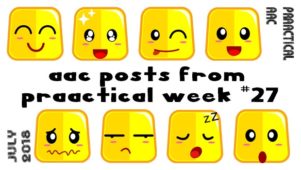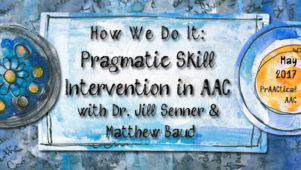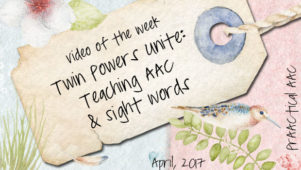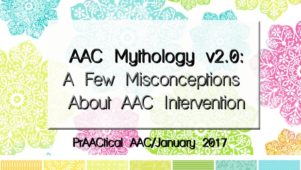From Conversation to Skill-building
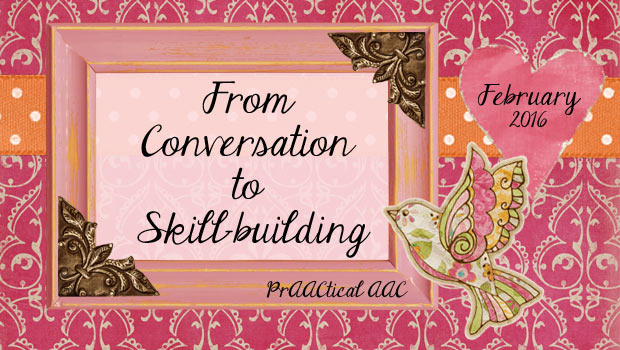
AAC learners need a lot of support as they build the skills needed to have rich and effective conversations. Often, their role in the conversation is punctuated with partners’ reliance on context, prior knowledge, and questions to make sense of the message. What do we do when the learner gives us partial information or uses language skills below his/her capability? Do we accept the limited language so that we get to the bottom of the message our learner is trying to express? Or do we use it as an opportunity to shape improved language skills?
One approach to making this decision is to start with a question.
“What is the top priority for this interaction?”
Making a decision about the most important goal of the conversation is a critical step in determining how to respond. In some cases, the time is right to use the opportunity to improve skills in syntax, morphology, or semantics. We can honor the intent of the message, respond accordingly, and then plunge right into direct instruction of the target skills.
In other cases, the top priority may be the exchange of information. Sometimes, getting our point across takes top priority. When the AAC learner has something that he/she want us to know, or when we need to tell the learner something, it changes the focus of the conversation. In these situations, the focal point is about understanding. It’s about clarity, not completeness or correctness.
When Jeremiah came to a session and said ‘go Disney,’ it was clear that he had exciting news to share. The best responses to situations like that are all about enthusiastically honoring the intent of the communicator. This is the time to use strategies like recasts, aided language input, and expansions because those provide models of more sophisticated ways to express thoughts. We use well-placed questions (E.g.,“Who is going?” “Did it happen already?”) to help Jeremiah add information that gives us a more complete idea of what he was trying to express with his simple 2-word utterance.
“But shouldn’t I get him to expand the utterance or use correct grammar?”
Possibly, but not necessarily. If I am confident that the AAC learner has the skills to spontaneously say “We’re going to Disney over break,” I might push for a more complete utterance. “Wow! Go Disney. That sounds exciting. I’m wondering WHO is going and WHEN they are going.” My enthusiastic tone, interested body language, and exaggerated pause time sends Jeremiah the signal that I am expecting a more detailed response.
If I don’t feel confident that the learner can create a fuller sentence independently and relatively easily, however, I’d probably refrain from this approach. Our goals for learners at this stage include keeping them excited about telling us things. As we all know, the more difficult that process is, the less likely they are to want to start a conversation. When communicating with AAC is still quite a challenge, the focus is on content. Tell me any way you can, and we will go from there.
For interventionists, this can be harder than it seems.
“Go Disney.” On one hand, it’s clearly a motivating topic, which means that I might be able to get a little more therapeutic mileage from it (so tempting!). On the other hand, if I choose to do some instruction and have Jeremiah repeat utterance using a better quality of sentence, he might get discouraged and be less likely to share news in the future. Anytime we’ve discouraged an AAC learner from communicating, we’ve got a real problem on our hands. It’s hard to build language in someone who doesn’t want to talk to us.
“But, how will he develop better language if I don’t push him to use better sentences?”
Good point!
One strategy is to come back to it later. For the moment, keep the focus on the content so that our AAC learner can express the main idea of what he wanted to convey. As communication partners, we can use the context for the interaction and questions to get the learner share more information so that we can better understand what he wants to tell us. At the same time, we might make some notes as to what each of us said so that we can revisit this later. This allows us to ‘rewind and replay’ the conversation in another session so that we can use this powerfully motivating topic to build better language.
We might introduce this with a rationale that is meaningful to the client. E.g., “Jeremiah, yesterday you gave me some exciting news: you’re going to Disney over break. That’s so cool! I had to ask some questions to find out about it. Today, we’re going to practice talking about this so it is quicker and easier for you to tell other people, too.” Then, we can move onto expanding the short sentences into more robust utterances that will allow Jeremiah to get more fluent with speaking in this way (my priority) and be better able to share his big news with staff and friends (his priority).
You can read more thoughts on setting priorities in AAC interactions here. Have you found effective strategies to move from conversation to therapeutic learning? We’d love to hear about them.
Filed under: PrAACtical Thinking
Tagged With: intervention
This post was written by Carole Zangari

